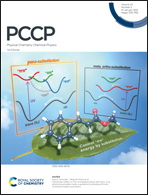New insights on the ESIPT process based on solid-state data and state-of-the-art computational methods†
Abstract
Benzothiazole derivatives were used as models to study the excited-state intramolecular proton transfer (ESIPT) from an experimental and theoretical point of view. The experimental electronic and vibrational results were compared with a comprehensive selection of state-of-the-art computational methods in a workflow approach. The latter were performed based on modern techniques, such as DLPNO-CCSD(T), which gives the reference energies and current methodologies for ESIPT analysis, such as molecular dynamics and charge density difference testing. The theoretical vibrational results were focused on the stretch vibrational-mode of the hydroxyl group, which indicated a large increase in the intramolecular hydrogen bond strength, which facilitates the ESIPT process. Theoretically, the optimization of a large number of molecules shows that π-stacking plays a fundamental role in benzothiazole stabilization, with a remarkably strong intramolecular hydrogen bond. The potential energy surface of the ESIPT reactive benzothiazole (4HBS) has a clear transition state where ESIPT is easily observed with a large difference in energy between the enol and keto tautomer. Additionally, molecular dynamics showed that the ESIPT process occurs very fast. The tautomer appears around 8.7 fs and the enolic form is regenerated in just 24 fs, closing the Förster cycle. The calculated Stokes shift could be related to the ESIPT process and the experimental solid-state emission spectrum matched almost perfectly with the theoretical one. In contrast, for the non-ESIPT benzothiazole (4HBSN), the agreement between theory and experiment was limited, probably due to intermolecular interaction effects that are not considered in these calculations.



 Please wait while we load your content...
Please wait while we load your content...